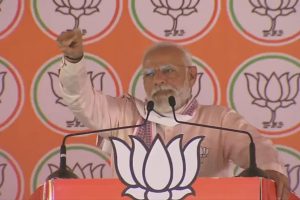With the launch of Chandrayaan-3, the Indian Space Research Organisation (ISRO) is embarking to achieve a successful soft landing on the Moon. India aims to become the fourth country in the world to achieve this feat, joining the ranks of the United States, Russia, and China.
Chandrayaan-3 is India’s third lunar mission and second attempt at achieving a soft landing on the Moon’s surface. It is a follow-on to the unsuccessful 2019 lunar mission – Chandrayaan-2. It will demonstrate India’s end-to-end capability in safe landing and roving on the lunar surface.
The Chandrayaan-3 spacecraft, which was launched on GSLV Mark 3 (LVM 3) heavy-lift launch vehicle successfully from the Satish Dhawan Space Centre in Andhra Pradesh’s Sriharikota on July 14, is scheduled to land on the surface of the moon on August 23.
The spacecraft has recently covered about two-thirds of the distance to the Moon and is currently undergoing a series of orbit manoeuvres.
Chandrayaan-3 components include various electronic and mechanical subsystems intended to ensure a safe and soft landing such as navigation sensors, propulsion systems, guidance and control among others. Additionally, there are mechanisms for the release of rover, two-way communication-related antennas and other onboard electronics.
The stated objectives of Chandrayaan-3 are safe and soft landing, rover roving on the moon’s surface, and in-situ scientific experiments.
The approved cost of Chandrayaan-3 is Rs 250 crores (excluding launch vehicle cost).
Chandrayaan-3’s development phase commenced in January 2020 with the launch planned sometime in 2021. However, the Covid-19 pandemic brought an unforeseen delay to the mission’s progress.
Chandrayaan-3 is the ISRO’s follow-up attempt after the Chandrayaan-2 mission faced challenges during its soft landing on the lunar surface in 2019 and was eventually deemed to have failed its core mission objectives.
The key scientific outcomes from Chandrayaan-2 include the first-ever global map for lunar sodium, enhancing knowledge on crater size distribution, unambiguous detection of lunar surface water ice with IIRS instrument and more. The mission has been featured in almost 50 publications.
During the Chandrayaan-1 mission, the satellite made more than 3400 orbits around the moon and the mission was concluded when the communication with the spacecraft was lost on August 29, 2009, according to the Indian Space Research Organisation (ISRO).
Chairman of the Indian Space Research Organisation (ISRO), S Somanath last week expressed confidence in the progress of the forthcoming lunar mission, Chandrayaan 3, providing reassurance that all systems are operating as planned.
Chairman S Somanath stated, “Everything is going fine now. There will be a series of manoeuvres until it lands (on the Moon) on 23rd August. The satellite is healthy.”
Moon serves as a repository of the Earth’s past and a successful lunar mission by India will help enhance life on Earth while also enabling it to explore the rest of the solar system and beyond.
K Sivan, former director of ISRO, earlier told ANI that the success of mission Chandrayan-3 will give a morale boost to programmes like Gaganyan, India’s first manned space mission.
Former ISRO scientist Nambi Narayanan, who has been instrumental in the country’s space sector innovation, had before the lift of the satellite said the Chandrayaan-3 mission is going to be successful and a game-changer event for India.
”Chandrayaan-3 will definitely be a game changer for India and I hope it will be successful. India will become an inspiration to the entire world. Let’s wait for the launch and pray for the best,” Nambi Narayanan had told ANI.
Narayanan is the scientist who led a team to develop the ‘Vikas Engine’ — a mainstay of all Indian rockets and help the country enter into the era of PSLV rockets.
“I’m assuming, and I hope that it will be a successful mission. Because whatever the problem in Chandrayaan-2, actually, we corrected the whole thing. From the failure, we have understood all mistakes (on our part),” Narayanan, the recipient of India’s third highest civilian honour, ‘Padma Bhushan’, told ANI.
Historically, spacecraft missions to the Moon have primarily targeted the equatorial region due to its favourable terrain and operating conditions. However, the lunar south pole presents a vastly different and more challenging terrain compared to the equatorial region.
Sunlight is scarce in certain polar regions, resulting in perpetually dark areas where temperatures can reach -230 degrees Celsius. This lack of sunlight and extreme cold pose difficulties for instrument operation and sustainability.
The lunar south pole offers extreme and contrasting conditions that pose challenges for humans but it makes them potential repositories of valuable information about the early Solar System. It is crucial to explore this region which could impact future deep space exploration.











